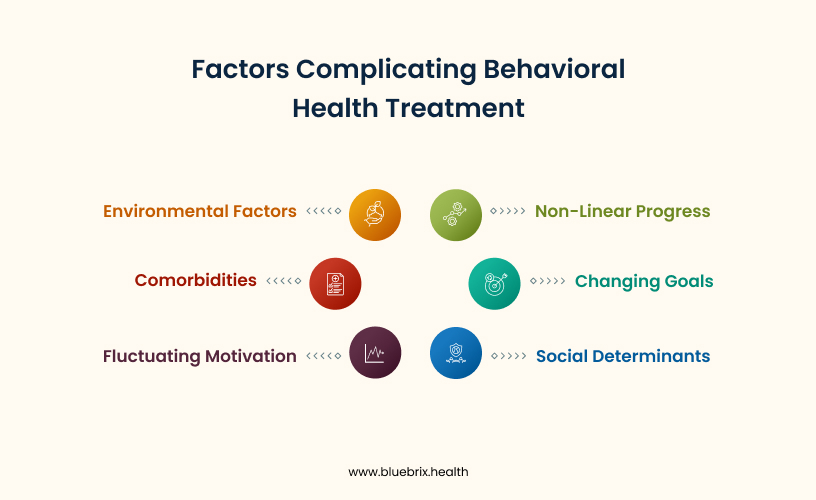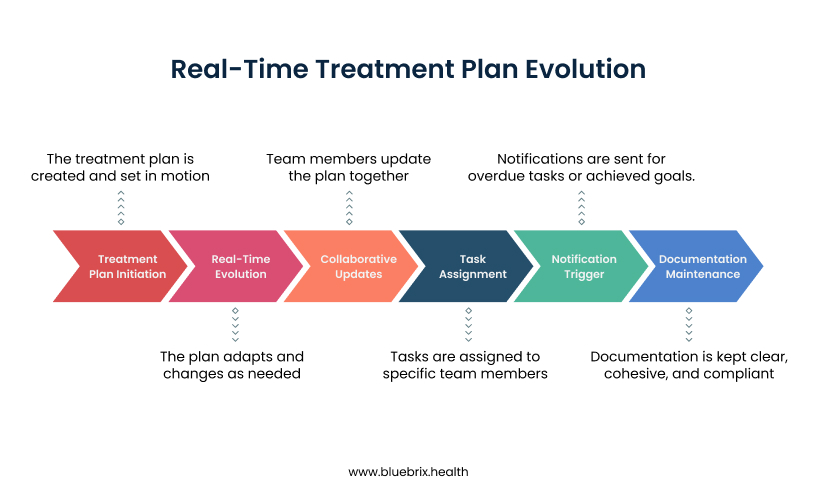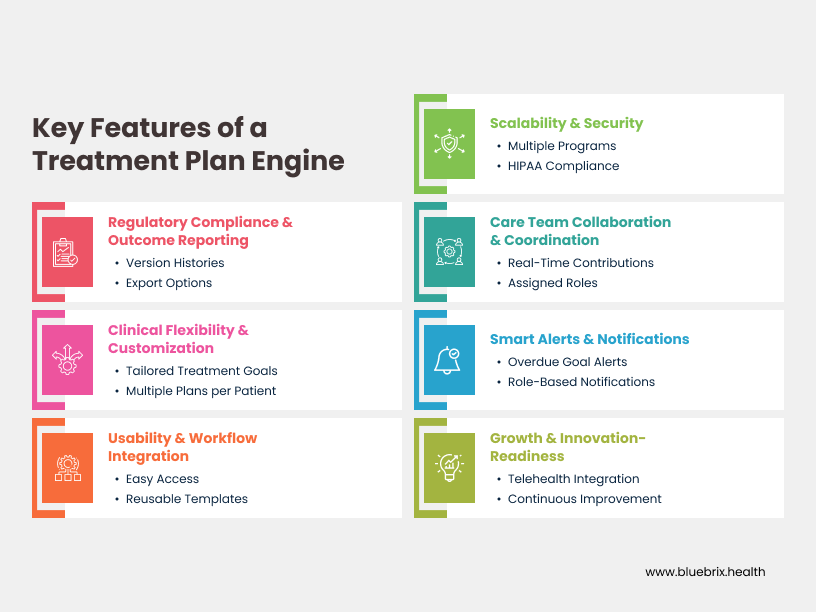
In behavioral health, no two treatment journeys are alike. Patients arrive with different diagnoses, life experiences, stressors, support systems, and healing timelines. Their goals are as varied as their personalities—ranging from managing daily routines to confronting complex trauma. So, why should their care plans be templated, static, or one-size-fits-all?
The truth is, many behavioral health organizations are still working with legacy electronic health records (EHRs) that treat treatment plans as compliance checklists rather than living documents. But as value-based care gains momentum and mental health becomes a national priority, flexible, responsive treatment plan engines are no longer optional—they’re a foundational requirement for quality care.
In this blog, we’ll explore why flexible treatment planning is critical in behavioral health, what providers and organizations need from their EHRs, and how purpose-built platforms like blueBriX are redefining what’s possible with intelligent, adaptable technology.
Why Treatment Planning Needs a Rethink in Behavioral Health
At its core, a treatment plan is a roadmap. It charts the path between where the patient is and where they hope to be. But this path isn’t straight—it twists, turns, pauses, and evolves. This is especially true in behavioral health, where:
- Progress isn’t always linear
- Goals change as insight deepens
- Social determinants can derail momentum
- Patient motivation fluctuates
- Comorbidities and environmental factors complicate recovery

Yet many EHRs handle treatment planning as a static process—largely disconnected from real-time care, patient feedback, or interdisciplinary input. Plans are created, filed away, and only revisited when required for compliance reviews or billing audits.
This approach undermines what makes behavioral health unique: its need for relational, iterative, and human-centered care.
Flexibility Isn’t a Feature—It’s a Clinical Necessity
Rigid systems force clinicians to work around the software, not with it. They spend valuable time trying to fit nuanced goals and diagnoses into narrow templates, risking oversimplification or missed context. Even worse, they may begin to document only what the system allows—diluting the clinical nuance that makes personalized care effective.
Why flexibility matters:
- Patient-centered care: Providers can tailor objectives, actions, and timelines to the individual—not just the diagnosis.
- Multidisciplinary collaboration: A flexible EHR supports different provider perspectives across psychiatry, therapy, case management, and peer support.
- Dynamic care journeys: Plans must evolve with life events, medication responses, crisis episodes, and progress (or regression).
- Regulatory demands: New models like value-based care require documentation of patient outcomes, engagement, and iterative updates.
According to a report by HealthIT.gov, 78% of behavioral health providers say “EHRs that don’t fit our workflows” are a barrier to care delivery. This isn’t just a technical issue—it’s a patient care issue.
The Promise of a Purpose-Built Platform
Enter blueBriX Behavioral Health EHR—an ecosystem designed not just to record information, but to enable smarter, more responsive care through its flexible Treatment Plan Engine.
Instead of forcing providers into predefined boxes, blueBriX empowers them to:
- Create and update treatment plans that reflect real-world complexity
- Collaborate across care teams in real time
- Receive proactive alerts and notifications tied to goals and outcomes
- Leverage intuitive dashboards that surface what matters, when it matters
This flexibility isn’t chaotic—it’s structured, governed, and smart. And it’s built specifically for behavioral health, not retrofitted from primary care workflows.
Bringing Treatment Plans to Life
Let’s imagine a typical behavioral health care team using blueBriX.
A licensed clinical social worker is working with a young adult facing anxiety and depression. The clinician creates an initial treatment plan based on intake assessments and client-stated goals. Over time:
- The client begins medication, which leads to side effects that shift their priorities.
- A peer support specialist identifies housing insecurity as a barrier to recovery.
- A psychiatrist joins the care team and wants to modify goals and interventions.
- The client begins school again, impacting therapy availability.
With a flexible EHR like blueBriX:
- The treatment plan evolves in real time.
- Action steps are updated collaboratively and assigned to the appropriate team member.
- Notifications are triggered when tasks are overdue or goals are achieved.
- Documentation remains clear, cohesive, and compliant.

This is more than documentation—it’s living care coordination.
From Static Compliance to Dynamic Accountability
Many EHRs treat treatment plans as administrative burdens. blueBriX treats them as core clinical tools. By enabling flexible configuration, the system ensures treatment plans serve both:
- Clinician goals: to track, treat, and adapt patient care effectively
- Organizational goals: to demonstrate measurable outcomes, reduce risk, and meet payer expectations
Some of the real-world benefits include:
- Improved care team communication through real-time updates and shared access
- Faster turnaround on documentation with user-driven templates and logic
- Higher plan adherence with alerts to review, revise, or reassess treatment goals
- Better engagement scores, as patients feel their plans are personalized and evolving with them
This directly aligns with value-based care models, which reward patient-centricity, continuity, and outcomes over volume.
Alerts That Do More Than Ping
A standout feature of the blueBriX platform is its intelligent Treatment Plan Notification Dashboard. Instead of relying on memory or manual to-do lists, providers get:
- Color-coded alerts for due dates, missed reviews, or status changes
- In-app notifications for changes to goals, objectives, or responsible team members
- Direct access to modify plans, assign tasks, or communicate updates
This transforms passive documentation into active clinical engagement. When a goal changes, the right people are informed. When a deadline approaches, the system nudges action. It’s not just data—it’s direction.
Technology That Follows Your Clinical Logic (Not the Other Way Around)
With blueBriX, clinicians can structure treatment plans in a way that mirrors their thinking and patient flow. They can:
- Define their own terminology and field labels
- Control which sections appear (and when)
- Map workflows based on diagnosis, provider type, or level of care
- Auto-link fields across goals, objectives, and progress updates
This means a therapist and a psychiatrist can both document in language that makes sense to their roles, while contributing to the same coordinated care plan. It’s interoperability at the human level.
A Smarter Way to Scale Quality
For behavioral health organizations aiming to grow, standardization and flexibility must coexist. With blueBriX:
- Templates allow consistent clinical documentation across programs
- Customizations support varied populations, from SUD to pediatric mental health
- Audit trails, version histories, and role-based access protect compliance
- Data from treatment plans can power quality reporting, predictive insights, and operational benchmarks
You’re not just managing care—you’re continuously improving it.
What To Look For in a Treatment Plan Engine
Whether you’re switching EHRs or evaluating your current setup, here are a few strategic questions to ask. This checklist can help you assess whether your current (or future) EHR system truly supports dynamic, person-centered care in behavioral health.

Clinical Flexibility & Customization
- Can clinicians tailor treatment goals, objectives, and action steps for each patient?
- Does the engine support multiple treatment plans per patient, across different programs or diagnoses?
- Can plans be revised mid-course without losing previous documentation or breaking the workflow?
- Are fields, sections, and workflows customizable without developer support?
Care Team Collaboration & Coordination
- Can different care team members (therapists, case managers, psychiatrists) contribute to the same treatment plan in real time?
- Are updates automatically visible to the entire team?
- Can roles and responsibilities be assigned within each plan?
- Does the system allow for real-time comments or logs attached to treatment goals?
Smart Alerts & Notifications
- Are clinicians alerted when treatment goals are overdue or modified?
- Can notifications be tailored by role (e.g., psychiatrist vs. peer support)?
- Are color-coded alerts available for priority issues like missed reviews or at-risk patients?
- Does the system support alerts for changes in diagnoses, medication, or progress metrics?
Usability & Workflow Integration
- Is the treatment plan easy to access directly from the patient record (e.g., facesheet or dashboard)?
- Can templates be created and reused across programs or provider types?
- Does the plan builder reflect actual clinical workflow rather than impose rigid structures?
- Are progress tracking and status updates seamless and intuitive?
Regulatory Compliance & Outcome Reporting
- Are version histories and audit trails automatically maintained?
- Can you export treatment plans in multiple formats (PDF, CSV, print)?
- Is documentation aligned with payer requirements, Medicaid standards, and accreditation bodies?
- Does the platform support reporting by treatment plan data (e.g., completed goals, review cycles)?
Scalability & Security
- Can the engine handle multiple programs and sub-programs under one system?
- Are access controls configurable at the team or user level?
- Is patient privacy maintained through role-based access to treatment information?
- Does the solution comply with HIPAA and behavioral health-specific security protocols?
Growth & Innovation-Readiness
- Does the EHR support new care models (e.g., telehealth-integrated plans, value-based care)?
- Are treatment plans linked to data insights, population health trends, or care outcomes?
- Can the system adapt as your organization grows, without re-engineering core workflows?
- Is there a roadmap for continuous improvement based on behavioral health best practices?
blueBriX Behavioral Health EHR is built from the ground up for flexibility, compliance, and outcomes. blueBriX was designed with these exact points in mind. And the result is a platform that supports what behavioral health truly demands—adaptability, empathy, coordination, and growth.
Final Thoughts: The Future Is Personalized, Not Predefined
In the world of behavioral health, treatment planning isn’t a checkbox. It’s a conversation. A commitment. A collaboration.
As the industry moves toward whole-person care, digital tools must evolve to keep up. EHRs should support flexibility, not stifle it. They should amplify clinical reasoning, not override it. They should be built for behavioral health, not forced to fit it.
That’s why flexible treatment plan engines aren’t a luxury—they’re a leadership decision. They directly impact how your teams operate, how your patients heal, and how your organization thrives.
With blueBriX, you’re not just planning treatment—you’re powering transformation.
Want to see it in action?
Whether you’re a solo provider, a multi-location agency, or an enterprise health system—blueBriX gives you the tools to deliver dynamic, outcome-focused, and personalized behavioral health care.
Explore how your workflows can be transformed!